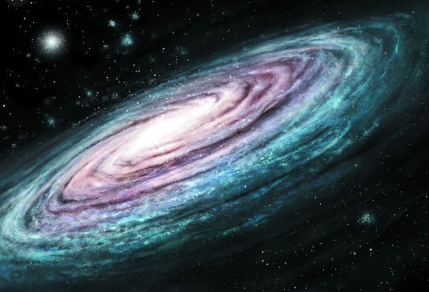Scott's new map is a GPS for the ages. It navigates to Earth using pulsars both inside and outside the Milky Way, with a twist.
斯考特的新地图是能恒久使用的GPS。它运用银河系以内及以外的脉冲星导航至地球。
Instead of the more ordinary pulsars Dad selected, the new map employs millisecond pulsars that spin faster, last longer, and have also-dead orbital companions. These binary pulsars afford a second set of identifiers: the orbital period of the system, which does not change over billions of years. And, crucially, millisecond pulsars age much more slowly than the ones in Dad's map, meaning that it takes thousands of times longer for their spins to become unrecognizable.
与其使用我父亲挑选的那些较普通的脉冲星,这幅新地图运用的是毫秒脉冲星,它们自转得更快,能存在更久,而且有已经死亡的伴星和它们一起在轨道上运行。脉冲星双星提供了第二组辨识特征:这种系统的轨道周期在数十亿年内都不会改变。而且关键在于,毫秒脉冲星的衰老速度远比我父亲地图上的那些脉冲星慢,这意味着在它们的自转失去辨识度以前,历时会比过去的脉冲星多数千倍。

In addition, Scott included another layer of signposts: pulsars in globular clusters orbiting the Milky Way. Ancient clumps of stars that predate the Milky Way, globular clusters are gorgeous and mysterious, and they are veritable millisecond pulsar factories.
此外,斯考特还查了另一层路标:绕行银河系的球状星团里的脉冲星。球状星团是比银河系更古老的恒星团,既美丽又神秘,而且简直是制造毫秒脉冲星的工厂。
By including signposts in these hard-to-miss stellar globs outside the galaxy, Scott's map allows Earth to be discoverable for billions of years, even after the Milky Way's stars have trekked around the galactic core multiple times, shuffling their positions and obliterating constellations.
一旦有位于明显可见的银河系外球状星团里的路标,无论银河系的恒星绕着银河系核心运行多少圈,改变了它们的位置并导致星座消失,斯考特的地图仍能让地球在未来数十亿年内被找到。
And Dad, for the record, thinks that's spectacular.
另外在此写下以资记录:我父亲认为这想法太棒了。












